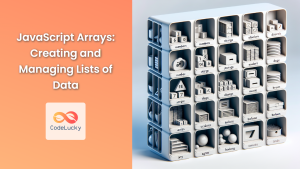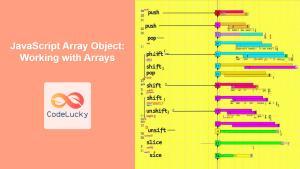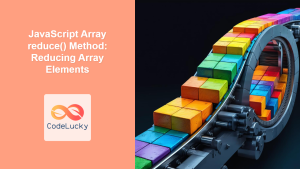JavaScript destructuring is a powerful feature introduced in ES6 (ECMAScript 2015) that allows you to extract values from arrays or properties from objects and assign them to distinct variables in a more concise and readable way. This technique can significantly simplify your code and make it more expressive. In this comprehensive guide, we'll explore the ins and outs of destructuring in JavaScript, covering both array and object destructuring with numerous practical examples.
Array Destructuring
Array destructuring allows you to unpack values from an array into distinct variables. This can be particularly useful when working with functions that return multiple values or when you want to extract specific elements from an array.
Basic Array Destructuring
Let's start with a simple example:
const fruits = ['apple', 'banana', 'cherry'];
const [first, second, third] = fruits;
console.log(first); // Output: 'apple'
console.log(second); // Output: 'banana'
console.log(third); // Output: 'cherry'
In this example, we're unpacking the fruits array into three separate variables: first, second, and third. The square brackets [] on the left side of the assignment indicate that we're performing array destructuring.
Skipping Elements
You can easily skip elements in the array by leaving empty spaces in the destructuring pattern:
const colors = ['red', 'green', 'blue', 'yellow'];
const [primary, , tertiary] = colors;
console.log(primary); // Output: 'red'
console.log(tertiary); // Output: 'blue'
Here, we've skipped the second element ('green') by leaving an empty space between the commas.
Rest Pattern
The rest pattern allows you to collect the remaining elements of an array into a new array:
const numbers = [1, 2, 3, 4, 5];
const [first, second, ...rest] = numbers;
console.log(first); // Output: 1
console.log(second); // Output: 2
console.log(rest); // Output: [3, 4, 5]
The ...rest syntax collects all remaining elements into a new array called rest.
Default Values
You can assign default values to variables in case the array doesn't have enough elements:
const [a = 1, b = 2, c = 3] = [4, 5];
console.log(a); // Output: 4
console.log(b); // Output: 5
console.log(c); // Output: 3
In this example, c takes its default value of 3 because the array only has two elements.
Swapping Variables
Destructuring provides an elegant way to swap variables without using a temporary variable:
let x = 10;
let y = 20;
[x, y] = [y, x];
console.log(x); // Output: 20
console.log(y); // Output: 10
This swaps the values of x and y in a single line of code.
Nested Array Destructuring
You can also destructure nested arrays:
const nestedArray = [1, [2, 3], 4];
const [a, [b, c], d] = nestedArray;
console.log(a); // Output: 1
console.log(b); // Output: 2
console.log(c); // Output: 3
console.log(d); // Output: 4
This example demonstrates how to unpack values from a nested array structure.
Object Destructuring
Object destructuring allows you to extract properties from objects and bind them to variables. This can be particularly useful when working with complex objects or when you want to extract specific properties from an object.
Basic Object Destructuring
Let's start with a simple example:
const person = {
name: 'John Doe',
age: 30,
city: 'New York'
};
const { name, age, city } = person;
console.log(name); // Output: 'John Doe'
console.log(age); // Output: 30
console.log(city); // Output: 'New York'
In this example, we're extracting the name, age, and city properties from the person object and assigning them to variables with the same names.
Assigning to Different Variable Names
You can assign object properties to variables with different names:
const { name: fullName, age: years, city: location } = person;
console.log(fullName); // Output: 'John Doe'
console.log(years); // Output: 30
console.log(location); // Output: 'New York'
Here, we're assigning the name property to a variable called fullName, age to years, and city to location.
Default Values
Similar to array destructuring, you can assign default values to variables in case the property doesn't exist in the object:
const { name, age, country = 'USA' } = person;
console.log(name); // Output: 'John Doe'
console.log(age); // Output: 30
console.log(country); // Output: 'USA'
In this example, country takes the default value 'USA' because it's not present in the person object.
Rest Pattern in Object Destructuring
The rest pattern can also be used with object destructuring to collect remaining properties:
const { name, ...rest } = person;
console.log(name); // Output: 'John Doe'
console.log(rest); // Output: { age: 30, city: 'New York' }
The ...rest syntax collects all remaining properties into a new object called rest.
Nested Object Destructuring
You can destructure nested objects as well:
const user = {
id: 42,
details: {
name: 'Jane Doe',
age: 28,
address: {
street: '123 Main St',
city: 'Anytown'
}
}
};
const { id, details: { name, age, address: { street, city } } } = user;
console.log(id); // Output: 42
console.log(name); // Output: 'Jane Doe'
console.log(age); // Output: 28
console.log(street); // Output: '123 Main St'
console.log(city); // Output: 'Anytown'
This example shows how to extract values from a deeply nested object structure.
Combining Array and Object Destructuring
You can combine array and object destructuring for more complex data structures:
const data = [
{ id: 1, name: 'Alice' },
{ id: 2, name: 'Bob' },
{ id: 3, name: 'Charlie' }
];
const [, { name: secondPersonName }] = data;
console.log(secondPersonName); // Output: 'Bob'
In this example, we're extracting the name property from the second object in the data array.
Practical Applications of Destructuring
Now that we've covered the basics, let's look at some practical applications of destructuring in real-world scenarios.
Function Parameter Destructuring
Destructuring can be used to simplify function parameters, especially when dealing with configuration objects:
function createUser({ username, email, age = 18 }) {
console.log(`Creating user: ${username}`);
console.log(`Email: ${email}`);
console.log(`Age: ${age}`);
}
createUser({ username: 'johndoe', email: '[email protected]' });
// Output:
// Creating user: johndoe
// Email: [email protected]
// Age: 18
This approach makes the function call cleaner and allows for default values.
Destructuring in Loops
Destructuring can be particularly useful in for...of loops when working with arrays of objects:
const users = [
{ id: 1, name: 'Alice', age: 30 },
{ id: 2, name: 'Bob', age: 25 },
{ id: 3, name: 'Charlie', age: 35 }
];
for (const { name, age } of users) {
console.log(`${name} is ${age} years old.`);
}
// Output:
// Alice is 30 years old.
// Bob is 25 years old.
// Charlie is 35 years old.
This approach allows you to directly access the properties you need in each iteration.
Destructuring in Module Imports
When working with modules, destructuring can make imports more specific and readable:
// math.js
export const add = (a, b) => a + b;
export const subtract = (a, b) => a - b;
export const multiply = (a, b) => a * b;
// main.js
import { add, multiply } from './math.js';
console.log(add(5, 3)); // Output: 8
console.log(multiply(4, 2)); // Output: 8
This allows you to import only the specific functions you need from a module.
Destructuring API Responses
When working with API responses, destructuring can help extract relevant data:
const apiResponse = {
status: 'success',
data: {
user: {
id: 123,
name: 'John Doe',
email: '[email protected]'
},
posts: [
{ id: 1, title: 'Hello World' },
{ id: 2, title: 'JavaScript is awesome' }
]
}
};
const {
status,
data: {
user: { name, email },
posts: [firstPost, secondPost]
}
} = apiResponse;
console.log(status); // Output: 'success'
console.log(name); // Output: 'John Doe'
console.log(email); // Output: '[email protected]'
console.log(firstPost.title); // Output: 'Hello World'
console.log(secondPost.title); // Output: 'JavaScript is awesome'
This example demonstrates how to extract nested data from a complex API response using destructuring.
Advanced Destructuring Techniques
Let's explore some advanced techniques and edge cases in destructuring.
Computed Property Names
You can use computed property names in object destructuring:
const key = 'name';
const { [key]: value } = { name: 'Alice' };
console.log(value); // Output: 'Alice'
This allows for dynamic property access during destructuring.
Destructuring with Generators
Destructuring works well with generator functions:
function* fibs() {
let a = 0;
let b = 1;
while (true) {
yield a;
[a, b] = [b, a + b];
}
}
const [first, second, third, fourth, fifth] = fibs();
console.log(first, second, third, fourth, fifth);
// Output: 0 1 1 2 3
This example generates the first five Fibonacci numbers using destructuring with a generator function.
Destructuring in Try-Catch Blocks
You can use destructuring in catch blocks to extract specific properties from error objects:
try {
throw new Error('Something went wrong');
} catch ({ name, message }) {
console.log(name); // Output: 'Error'
console.log(message); // Output: 'Something went wrong'
}
This allows for more precise error handling by directly accessing the error properties.
Destructuring with Regular Expressions
When using regular expressions with the exec method, you can destructure the returned array:
const re = /(\d{4})-(\d{2})-(\d{2})/;
const [, year, month, day] = re.exec('2023-05-15');
console.log(year); // Output: '2023'
console.log(month); // Output: '05'
console.log(day); // Output: '15'
This technique allows you to easily extract captured groups from a regular expression match.
Performance Considerations
While destructuring is a powerful feature, it's important to consider its performance implications in certain scenarios.
Deep Cloning with Destructuring
Destructuring can be used for shallow cloning of objects and arrays:
const original = { a: 1, b: 2, c: { d: 3 } };
const clone = { ...original };
console.log(clone); // Output: { a: 1, b: 2, c: { d: 3 } }
console.log(clone.c === original.c); // Output: true
Note that this creates a shallow clone, meaning nested objects are still referenced, not copied.
Destructuring in Loops
While destructuring in loops can make code more readable, it can also impact performance if done excessively:
const items = [
{ id: 1, name: 'Item 1' },
{ id: 2, name: 'Item 2' },
// ... many more items
];
// Less efficient
for (const { id, name } of items) {
console.log(id, name);
}
// More efficient for large arrays
for (let i = 0; i < items.length; i++) {
const { id, name } = items[i];
console.log(id, name);
}
For large arrays, the second approach may be more performant as it avoids creating a new destructuring context for each iteration.
Conclusion
JavaScript destructuring is a powerful feature that can significantly improve code readability and reduce the amount of boilerplate code needed to work with complex data structures. From basic array and object unpacking to advanced techniques like nested destructuring and use with generators, this feature offers a wide range of possibilities for writing cleaner, more expressive code.
By mastering destructuring, you can write more efficient and maintainable JavaScript code, handling complex data structures with ease. Whether you're working with API responses, managing function parameters, or simply trying to extract specific values from arrays and objects, destructuring provides a elegant and powerful solution.
Remember to consider the performance implications when using destructuring, especially in performance-critical sections of your code. Used judiciously, destructuring can be a valuable tool in any JavaScript developer's toolkit, enhancing both the development experience and the quality of the resulting code.
As you continue to work with JavaScript, look for opportunities to apply destructuring in your projects. It's a feature that becomes more powerful and intuitive the more you use it, opening up new ways to structure and manipulate data in your applications.



















